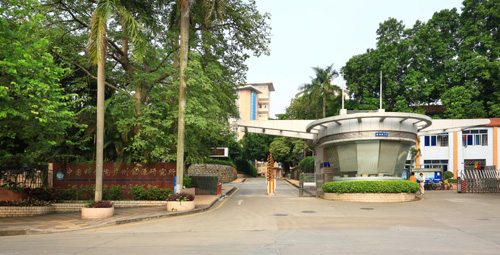中国科学院广州能源研究所成立于1978年,其前身为1973年成立的广东省地热研究室。1998年4月,原中国科学院广州人造卫星观测站并入广州能源所。2001年成为中国科学院知识创新工程试点单位之一。2015年进入中科院清洁能源特色研究所培育阶段,2017年参与筹建中科院清洁能源创新研究院和南海生态环境工程创新研究院。
广州能源所定位于可再生能源、新能源、节能环保及相关战略研究等领域的应用基础与关键技术、方法研发,围绕国家战略需求提供能源咨询服务。广州能源所在“一三五”规划实施过程中,梳理凝练研发方向,确立“生物质高效转化与规模化高值利用”“分布式可再生能源多能互补独立系统”“天然气水合物基础物性、成藏理论、开采及综合利用关键技术”等三个重大突破和“太阳能光热光电材料开发技术”“先进能源材料开发技术”“储能关键技术及应用示范”“可再生能源利用过程节能环保关键技术”“能源战略及低碳发展”等五个重点培育优势发展领域。广州能源所作为骨干成员单位,完成中科院洁净能源创新研究院和南海生态环境创新工程研究院等机构共建验收工作,稳步推进洁净能源创新研究院(广州)的建设,并支持国家能源实验室、广州明珠科学园建设等。
广州能源所是国家能源生物燃料研发中心、天然气水合物国家重点实验室分室、中国科学院可再生能源重点实验室、中国科学院天然气水合物重点实验室、中国科学院广州天然气水合物研究中心和广东省新能源和可再生能源研究开发与应用重点实验室的依托单位,建有国家可再生能源综合技术国际研发中心、国家能源生物燃料研发中心、广东省分布式储能及智能微电网工程中心等研发平台,是国家生物质能源产业技术创新战略联盟理事长单位、广东省分布式能源互联网产业联盟理事单位。广州能源所是中国可再生能源学会生物质能专业委员会、天然气水合物专业委员会以及广东省太阳能学会的挂靠单位。科研单元包括21个研究室,形成了以生物质能、海洋能、太阳能、地热能、固体废弃物能、天然气水合物、节能与环保、分布式综合能源系统集成及智能微电网应用为重点方向的学科布局。建有公共仪器分析测试平台,拥有大型分析测试仪器90余台(套)。

Guangzhou Institute of Energy Research, CAS was founded in 1978. Its predecessor was Guangdong Geothermal Laboratory established in 1973. In April 1998, the former Guangzhou Satellite Observation Station of the Chinese Academy of Sciences was merged into Guangzhou Energy Institute. In 2001, it became one of the pilot units of Knowledge Innovation Project of the Chinese Academy of Sciences. In 2015, it entered the cultivation stage of the Institute of Clean Energy Characteristics of the Chinese Academy of Sciences. In 2017, it participated in the preparation of the Clean Energy Innovation Institute of the Chinese Academy of Sciences and the South China Sea Eco-Environmental Engineering Innovation Institute.
Guangzhou Energy Institute focuses on the research and development of key technologies and methods in the fields of renewable energy, new energy, energy conservation and environmental protection and related strategic research, and provides energy consulting services around the national strategic needs. During the implementation of the "135-Year Plan", Guangzhou Energy Institute sorted out and condensed the research and development direction. Three major breakthroughs have been established: "Efficient conversion and large-scale high-value utilization of biomass", "Multi-energy complementary independent System of distributed renewable energy", "Key technologies of basic physical properties, accumulation theory, exploitation and comprehensive utilization of natural gas hydrate", and "development technology of solar photothermal optoelectronic materials", "Development technology of advanced energy materials", "Key Technologies and Application Demonstration of energy storage" and "renewable energy" Using key technologies of process energy saving and environmental protection ", "Energy strategy and low-carbon development" and other five key areas of competitive development. As a key member unit, Guangzhou Institute of Energy has completed the joint construction and acceptance work of Clean Energy Innovation Institute of Chinese Academy of Sciences and South China Sea Eco-Environmental Innovation Engineering Institute, steadily promoted the construction of Clean Energy Innovation Institute (Guangzhou), and supported the construction of National Energy Laboratory and Guangzhou Pearl Science Park.
Guangzhou Institute of Energy is the supporting unit of the National Energy Biofuel Research and Development Center, the State Key Laboratory of Natural Gas Hydrate, the Key Laboratory of Renewable Energy, the Key Laboratory of Natural Gas Hydrate, the Guangzhou Research Center of Natural Gas Hydrate, and the Key Laboratory of New and Renewable Energy Research, Development and Application of Guangdong Province. The company has established R&D platforms such as National International Research and Development Center for Comprehensive renewable Energy Technology, National Energy Biofuel Research and Development Center, and Guangdong Distributed Energy Storage and Smart Microgrid Engineering Center. It is the chairman unit of National Biomass Energy Industry Technology Innovation Strategy Alliance and the director unit of Guangdong Distributed Energy Internet Industry Alliance. Guangzhou Institute of Energy is affiliated to the Biomass Energy Committee of China Renewable Energy Society, the Natural Gas Hydrate Committee and the Guangdong Solar Energy Society. The scientific research unit consists of 21 research LABS, forming a discipline layout focusing on biomass energy, Marine energy, solar energy, geothermal energy, solid waste energy, natural gas hydrate, energy conservation and environmental protection, distributed integrated energy system integration and smart microgrid application. Built a public instrument analysis and testing platform, with more than 90 sets of large analysis and testing instruments.